Tesla Model 3: Contactor - Fast Charge - HV Battery (Remove and Replace)
Contactor - Fast Charge - HV Battery - Remove

SPECIAL TOOLS
Ratchet, 1/4" Sq Dr, HV Insulated (1057602-00-A)
Ext Bar, Wobble, 1/4" Dr, HV Insulated (1057603-00-A)
Skt, 1/4" Sq Dr, 13mm, HV Insulated (1057606-00-A)
Magnet, Flexible, HV Insulated, 18" (1057607-00-A)
Connector Removal, Coolant, PCS, M3 (1111868-00-B)
Kit, Svc Plug, Cooling Hose, Model 3 (1135762-00-A)
Skt, 1/4in Dr, 5-Lobe Torx Plus External (1059330-00-B)
Resistance meter, microohm, Hioki RM 3548 (1076927-00-A)
Warning:
Only technicians who have been trained in High Voltage Awareness are
permitted to perform this procedure. Proper personal protective equipment (PPE)
and insulating HV gloves with a minimum rating of class 0 (1000V) must be worn
at all times a high voltage cable, busbar, or fitting is handled. Refer to Tech
Note TN-15-92-003, "High Voltage Awareness Care Points" for additional safety
information.
Remove
- Drain the coolant from the power conversion system. See
Penthouse Coolant (Drain and Refill).
- Remove the HV battery negative contactor. See
Contactor - Negative - HV Battery (Remove and Replace).
- Remove the power conversion system coolant output tube. See
Tube - Output - Coolant - Power Conversion System (Remove and Replace).
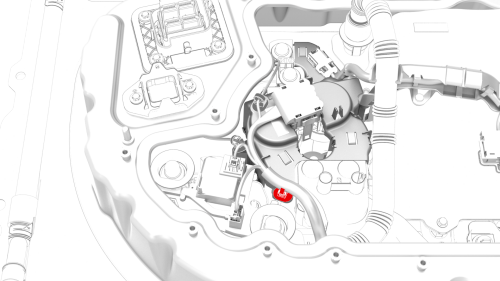
- Remove the clip that attaches the HV battery penthouse harness to the HV
battery fast charge contactor.
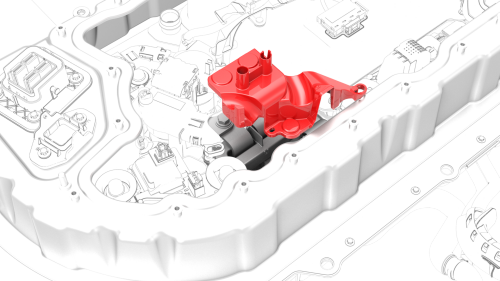
- Release the clips that attach the HV battery probing guide to the HV
battery and remove the guide from the penthouse.

- Disconnect the electrical harness from the HV battery fast charge
contactor connector.
Note: Squeeze the tabs on either side of the harness connector, to
release the tabs from the contactor connector.
Caution:
Do not pry the connectors apart, as this action breaks the tabs and
connectors, and necessitates harness replacement.

- Disconnect the HV battery AC inlet harness from the power conversion
system connector.
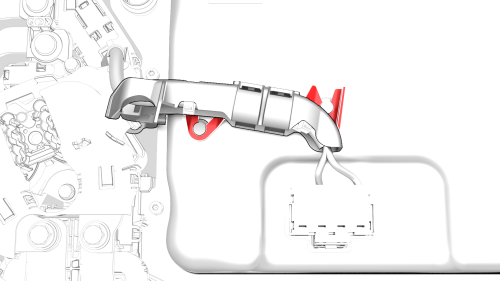
- Release the clips that attach the HV battery AC inlet harness cover to
the power conversion system.
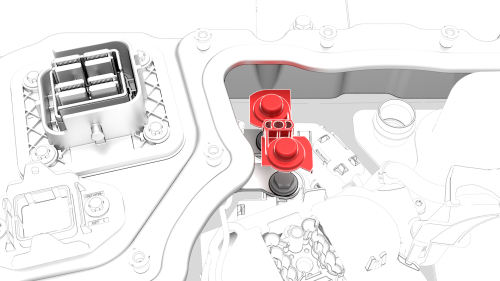
- Remove the insulator for the DC input assembly.

- Remove and discard the bolts that attach the negative and positive
busbars to the DC links and DC input.
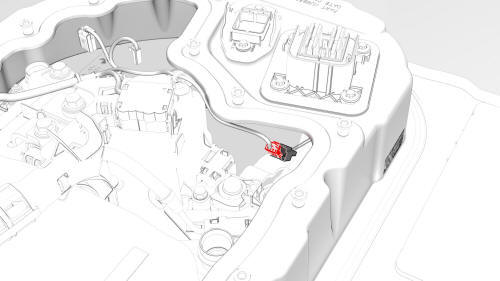
- Disconnect the electrical harness from the DC input assembly connector.
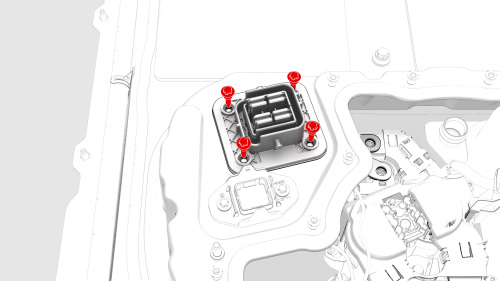
- Remove the bolts that attach the DC input assembly to the penthouse, and
then remove the DC input assembly from the vehicle.
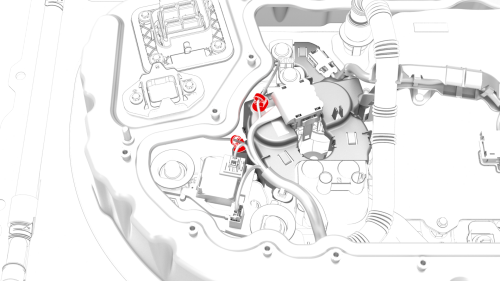
- Remove the clips that attach the HV battery penthouse harness to HV
battery fast charge contactor cover.
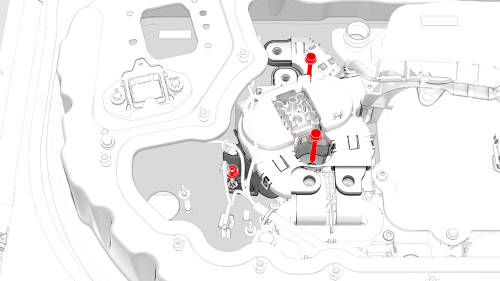
- Remove the nut and bolts that attach the fast charge contactor to the
penthouse, and remove the contactor with the harness from the vehicle.
- Remove the HV battery AC inlet harness from the contactor. See
Harness - AC Inlet - HV Battery (Remove and Replace).
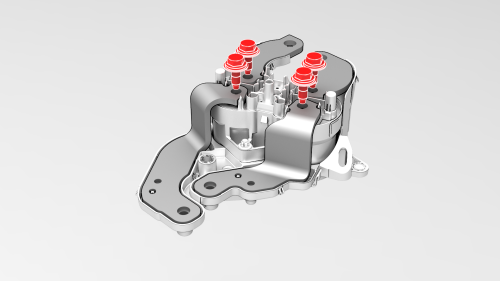
- Remove and discard the bolts that attach the busbars to the fast charge
contactor, and then remove the busbars from the contactor.
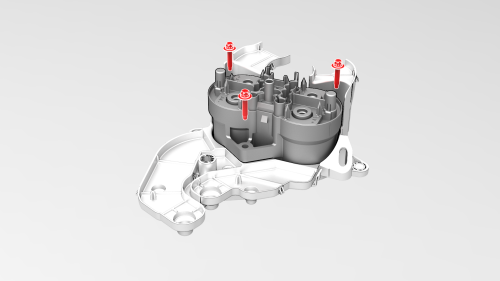
- Remove the bolts that attach the fast charge contactor to the insulator,
and remove the contactor from the insulator.
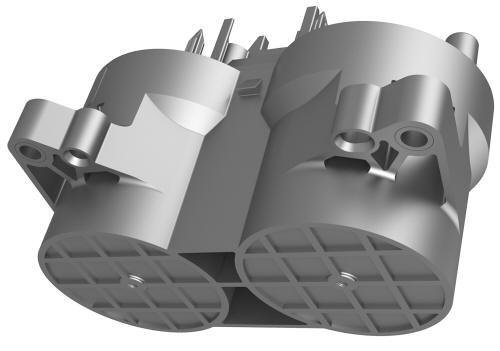
Contactor - Fast Charge - HV Battery - Install
Install
- Use IPA wipes to clean the high voltage mating surfaces of the fast
charge contactor and the positive and negative DC link and DC input busbars.
- Install the HV battery fast charge contactor to the insulator.
Note: Align the 2 guides as the fast charge contactor is installed
on the insulator.

- Install the bolts that attach the fast charge contactor to the insulator,
and then mark the bolts with a paint pen after they are torqued.
 Torque 5.5 Nm
Torque 5.5 Nm
- Install the positive and negative inlet and DC link busbars to the fast
charge contactor, install the new bolts (x4) that attach the busbars to the
contactor, and then mark the bolts with a paint pen after they are torqued.
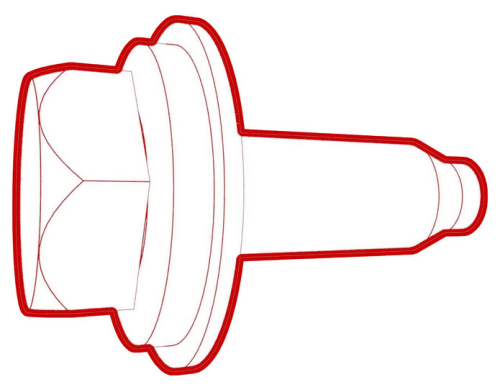
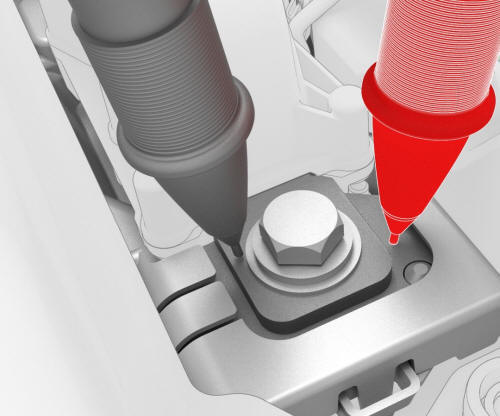 Generic Measurement - Actual busbars and fasteners might appear
different
Generic Measurement - Actual busbars and fasteners might appear
different
- Use the Hioki resistance meter to measure the resistance between the
positive (LH) HV joint bolt head of the fast charge contactor and the
respective positive (LH) inlet busbar, and then the resistance between the
positive (LH) HV joint bolt head of the fast charge contactor and the
respective positive (LH) DC link busbar.
Note: The maximum acceptable resistance is 0.030 mΩ (30 μΩ) per
joint. If the resistance is above this value, escalate a Toolbox session, as
appropriate.
 Generic Measurement - Actual busbars and fasteners might appear
different
Generic Measurement - Actual busbars and fasteners might appear
different
- Use the Hioki resistance meter to measure the resistance between the
negative (RH) HV joint bolt head of the fast charge contactor and the
respective negative (RH) inlet busbar, and then the resistance between the
negative (RH) HV joint bolt head of the fast charge contactor and the
respective negative (RH) DC link busbar.
Note: The maximum acceptable resistance is 0.040 mΩ (40 μΩ) per
joint. If the resistance is above this value, escalate a Toolbox session, as
appropriate.
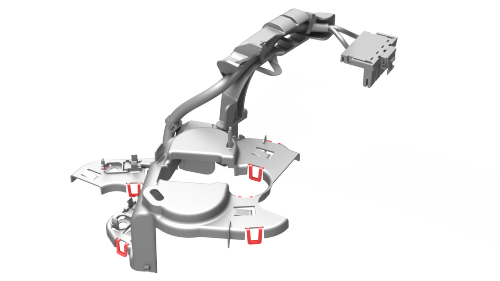
- Install a new HV battery AC inlet harness to the fast charge contactor.
See
Harness - AC Inlet - HV Battery (Remove and Replace).
Note: The AC inlet harness is a one time use.
- Install the bolts and nut that attach the fast charge assembly to the
penthouse, and then mark the bolts and nut with a paint pen after they are
torqued.
 Torque 5.5 Nm
Torque 5.5 Nm
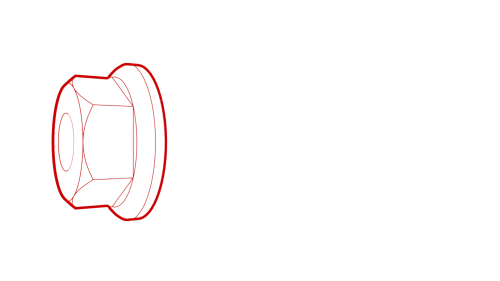 Torque 8 Nm
Torque 8 Nm
.png)
.png)
- Install the clips that attach the HV battery penthouse harness to HV
battery fast charge contactor cover.
.png)
- Install the DC input assembly to the penthouse, install the bolts (x4)
that attach the DC input assembly to the penthouse, and then mark the bolts
with a paint pen after they are torqued..
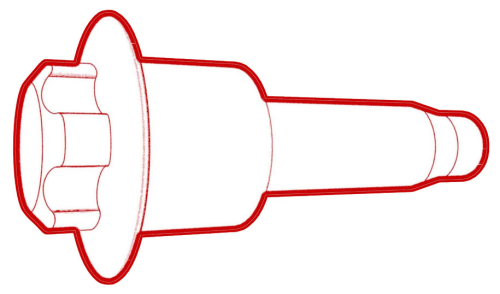 Torque 6 Nm
Torque 6 Nm
.jpg)
- Connect the electrical harness to the DC input assembly connector.
.png)
- Install new bolts (x4) to attach the negative and positive busbars to
the DC links and DC input, and then mark the bolts with a paint pen after
they are torqued.
.png) Torque 9 Nm
Torque 9 Nm
 Generic Measurement - Actual busbars and fasteners might appear
different
Generic Measurement - Actual busbars and fasteners might appear
different
- Use the Hioki resistance meter to measure the resistance at the HV joint
between the positive DC input busbar and the positive (LH) fast charge
contactor busbar.
Note: The maximum acceptable resistance is 0.060 mΩ (60 μΩ). If the
resistance is above this value, escalate a Toolbox session, as appropriate.
 Generic Measurement - Actual busbars and fasteners might appear
different
Generic Measurement - Actual busbars and fasteners might appear
different
- Use the Hioki resistance meter to measure the resistance at the HV joint
between the positive (LH) DC link busbar and the positive (LH) fast charge
contactor busbar.
Note: The maximum acceptable resistance is 0.040 mΩ (40 μΩ). If the
resistance is above this value, escalate a Toolbox session, as appropriate.
 Generic Measurement - Actual busbars and fasteners might appear
different
Generic Measurement - Actual busbars and fasteners might appear
different
- Use the Hioki resistance meter to measure the resistance at the HV joint
between the negative DC input busbar and the negative (RH) fast charge
contactor busbar.
Note: The maximum acceptable resistance is 0.060 mΩ (60 μΩ). If the
resistance is above this value, escalate a Toolbox session, as appropriate.
 Generic Measurement - Actual busbars and fasteners might appear
different
Generic Measurement - Actual busbars and fasteners might appear
different
- Use the Hioki resistance meter to measure the resistance at the HV joint
between the negative (RH) DC link busbar and the negative (RH) fast charge
contactor busbar.
Note: The maximum acceptable resistance is 0.060 mΩ (60 μΩ). If the
resistance is above this value, escalate a Toolbox session, as appropriate.
.png)
- Install the insulator for the DC input assembly.
.png)
- Fasten the clips that attach the HV battery AC inlet harness cover to
the power conversion system.
.png)
- Connect the HV battery AC inlet harness to the power conversion system
connector.
.png)
- Connect the electrical harness to the HV battery fast charge contactor
connector.
.png)
- Install the HV battery probing guide into the penthouse, and then fasten
the clips that attach the guide to the HV battery.
.png)
- Install the clip that attaches the HV battery penthouse harness to the
HV battery fast charge contactor.
- Install the power conversion system coolant output tube. See
Tube - Output - Coolant - Power Conversion System (Remove and Replace).
Caution:
Make sure that the coolant output tube is securely connected by firmly
pressing down on the fittings, verify that both clips have fully engaged the
barb on the power conversion system and battery flange, and then pull up on the
fittings to check retention.
- Perform a penthouse coolant leak test. See
Penthouse Coolant Leak Test.
- Connect the 12V auxiliary battery negative terminal only.
.png) Torque 6 Nm
Torque 6 Nm
Caution:
Do not follow the procedure to connect 12V power at this time.
- Connect a 12V charger to the 12V auxiliary battery terminals.
- Refill the coolant. See
Penthouse Coolant (Drain and Refill).
- On the touchscreen, touch Controls > Safety & Security > Vehicle Power >
Power Off.
- Disconnect the 12V charger from the 12V auxiliary battery terminals.
- Disconnect the 12V auxiliary battery negative terminal.
- Install the HV battery negative contactor. See
Contactor - Negative - HV Battery (Remove and Replace)
READ NEXT:
Contactor - Negative - HV Battery- Remove
SPECIAL TOOLS
Ratchet, 1/4" Sq Dr, HV Insulated (1057602-00-A)
Ext Bar, Wobble, 1/4" Dr, HV Insulated (1057603-00-A)
Magnet, Flexible, HV Insulated, 18" (10
SEE MORE:
Remove
Remove the rear trunk sill trim. See Trim - Sill - Trunk (Remove and
Replace).
Use masking tape to mark the location of the trunk striker.
Remove the bolts that attach the trunk striker to the body, and then
remove the striker from the vehicle.
Install
Align the trunk
Remove
Remove the LH and RH lower A-pillar trim. See
Trim - A-Pillar - Lower - LH (Remove and Replace).
Remove the LH and RH upper A-pillar trims. See
Trim - A-Pillar - Upper - LH (Remove and Replace).
Remove the driver and front passenger seats. See
Seat - Driver (Remove and Replace).
Re
















 Torque 5.5 Nm
Torque 5.5 Nm
 Generic Measurement - Actual busbars and fasteners might appear
different
Generic Measurement - Actual busbars and fasteners might appear
different Generic Measurement - Actual busbars and fasteners might appear
different
Generic Measurement - Actual busbars and fasteners might appear
different
 Torque 5.5 Nm
Torque 5.5 Nm
 Torque 8 Nm
Torque 8 Nm.png)
.png)
.png)
 Torque 6 Nm
Torque 6 Nm.jpg)
.png)
.png) Torque 9 Nm
Torque 9 Nm Generic Measurement - Actual busbars and fasteners might appear
different
Generic Measurement - Actual busbars and fasteners might appear
different Generic Measurement - Actual busbars and fasteners might appear
different
Generic Measurement - Actual busbars and fasteners might appear
different Generic Measurement - Actual busbars and fasteners might appear
different
Generic Measurement - Actual busbars and fasteners might appear
different Generic Measurement - Actual busbars and fasteners might appear
different
Generic Measurement - Actual busbars and fasteners might appear
different.png)
.png)
.png)
.png)
.png)
.png)
.png) Torque 6 Nm
Torque 6 Nm
